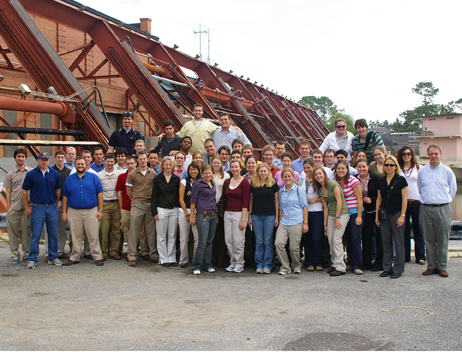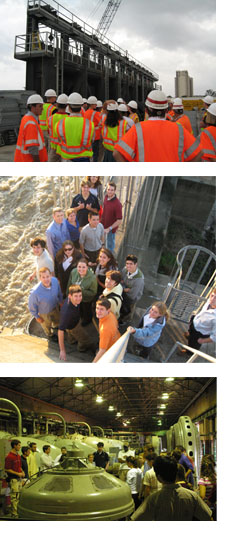


|
 |
On Location in the Big Easy
Although the area is vital to the country’s economy and culture, there is no quick fix to the challenges posed in rebuilding the Southern Louisiana Mississippi region in the wake of Hurricane Katrina. In addition to time and money, marshland ecology and environmental engineering, structural and soil engineering, hydraulic engineering, and plate tectonics also have to be considered.
 Notre Dame engineering faculty believed that one of
the best ways to help the students understand the challenges was to have
them learn about the area’s infrastructure firsthand, study why
the levee system failed, and explore the technologies that can help build
a better and safer flood protection system. To accomplish this, faculty
designed a tour of the area for students. Joining the group from Notre
Dame — 49 undergraduates, two graduate students, and four members
of the College of Engineering faculty and staff — were four members
of the U.S. Army Corps of Engineers stationed in the area.
Notre Dame engineering faculty believed that one of
the best ways to help the students understand the challenges was to have
them learn about the area’s infrastructure firsthand, study why
the levee system failed, and explore the technologies that can help build
a better and safer flood protection system. To accomplish this, faculty
designed a tour of the area for students. Joining the group from Notre
Dame — 49 undergraduates, two graduate students, and four members
of the College of Engineering faculty and staff — were four members
of the U.S. Army Corps of Engineers stationed in the area.
As students visited the New Orleans District and Engineer
Research and Development Center in November 2006, they met with senior
project managers from the Army Corps, the district engineer, and the
head of the Hurricane Protection Office, who outlined the reconstruction
process. Corps engineers also demonstrated physical models that are being
used to better understand levee behavior. Students toured the 26th largest
supercomputer in the world, which is being used to analyze hurricane
storm surge and hydrodynamic loads in the area, and they were able to
see pump stations and other facilities, such as the Old River Control
Structure.
Students and faculty also explored the link between natural geologic
processes and the engineered environment, specifically balancing the
needs of the environment with the safety of area residents and the economic
importance (locally and nationally) of waterways and ocean and inland
navigation. While in New Orleans they also saw a personal side to engineering,
the humanity motivating the technology.
To find out more about the trip and rebuilding efforts, visit http://www.nd.edu/~jjwteach/30125/fieldtrip.html
|
Copyright 2007. University of Notre Dame.